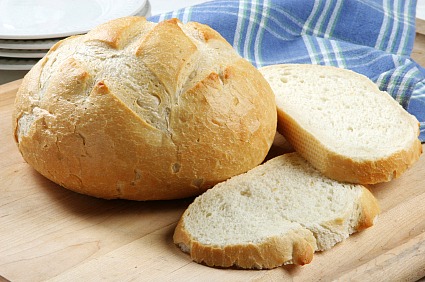 |
| Also known as "nomnomnomnomnom" |
The recipe is simple -- in fact, the one I used from Red Star Yeast was ever so slightly more complex than the bare minimum you need to make a sourdough starter.
 |
| Sourdough Starter! The Start of YOUR Sourdough Empire! |
- 2 cups water
- 3 1/2 cups bread flour
- 2 1/4 tsp RED STAR Active Dry Yeast
- 1 Tbsp sugar
You actually only need 1 part water to 1 part flour, and just let it hang for a few days, but the yeast helps kickstart the process, and the sugar helps kickstart the yeast. You let this thing sit for around 5 days in a warm spot, loosely (not tightly!) covered, and natural bacteria and yeasts in the air will ferment the starter all on its own. Then put the stuff in the fridge. You'll need to feed it more flour/water mix occasionally to keep it alive.
The actual recipe for sourdough bread will vary, but in short, you basically make bread the way you normally would, but add around 1 cup of sourdough starter to the mix. Then you add a cup of flour & water back to your starter mix, and let it sit for another day or so before putting it back in the fridge.
So long as you continue to occasionally feed it, you can literally keep sourdough starter alive for years. Some of the more venerable starters have been around more than a century, and are passed down thru families!
 |
| Now that's some hooch |
So yeah, I made this starter, and what's the big thing yeast does to sugars? It ferments it! I think adding the Red Star yeast in the mix helped jumpstart the fermentation process, because after 2 days I can really smell the alcohol. Now, that will all cook out in a bread, but I can also use this stuff to make a beer! There's a couple different ways, and you can read more about it here and here. But basically, you can either use the liquid that appears at the top of your starter over time (just be sure to replenish the water so the starter stays alive), kind of prison hooch style (ready in a couple weeks, in theory), or you can add a scoop or three to your wort when brewing regular beer. The second method will give you something similar to a cider or weissebeer, but you don't need to use quite as much malt as you'd normally use -- oh, and go easy on the hops. This style needs to age, though, and most people recommend around 4 months or longer. But it's so damn easy that I can't not try it!
 |
| They really make this stuff! |
Most likely I'll be making an experimental gallon of this stuff very soon; probably before I start on the next Taihei batch.
More to come in the future!